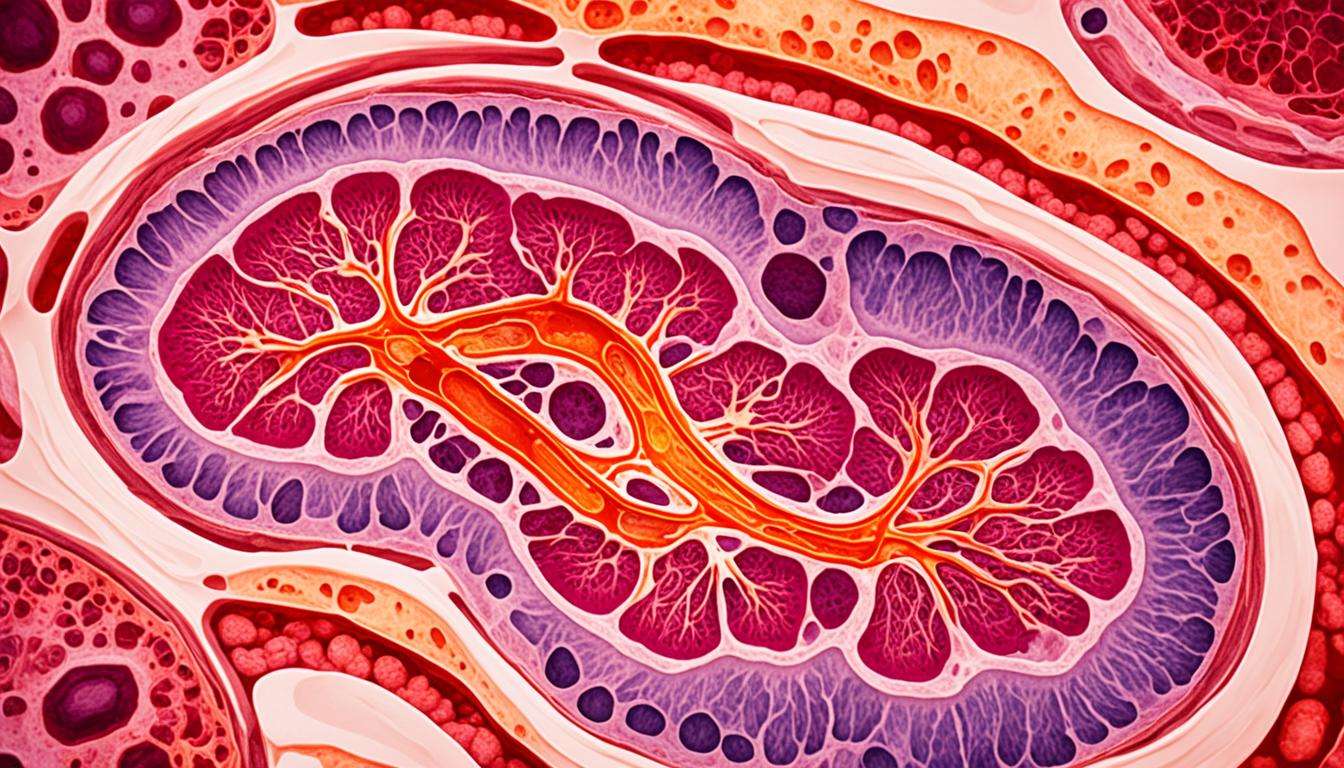Focal segmental glomerulosclerosis (FSGS) affects the kidneys. It damages the glomeruli, the parts that filter the blood. This condition is among the top reasons for chronic kidney disease worldwide, impacting 1% to 3% of people. Eventually, FSGS can cause kidney failure. There are few treatment choices, but stem cell therapy offers hope for those with FSGS.
Key Takeaways:
- FSGS is a kidney disease that damages the glomeruli, leading to chronic kidney disease.
- FSGS affects 1% to 3% of the global population.
- FSGS can result in kidney failure, and current treatment options have limitations.
- Stem cell therapy shows promise for the treatment of FSGS.
- Further research is needed to better understand the potential of stem cell therapy in managing FSGS.
Classification and Symptoms of FSGS
Focal segmental glomerulosclerosis (FSGS) is a kidney disease with various types. Knowing its types helps predict the outlook and best treatment.
Classification of FSGS
FSGS shows up in several ways:
- Classic FSGS: It’s the common form, identified by scarring in glomeruli segments.
- Perihilar FSGS: Scarring concentrates where kidney blood vessels enter the glomerulus.
- Tip Lesion FSGS: Known as peripheral FSGS, it shows scarring at the glomerulus’ end.
- Collapsing FSGS: It’s a severe type, progressing fast and damaging the glomeruli badly.
- Cellular FSGS: It’s marked by immune cells in the glomeruli.
Each FSGS type has its own traits and risks, impacting how it’s treated. For example, Collapsing FSGS raises the risk of kidney failure.
Symptoms of FSGS
FSGS brings on several signs, like:
- Swelling in the hands, feet, and ankles
- Unexplained weight gain
- High blood pressure
- Proteinuria (too much protein in urine)
- Low blood protein levels
- High blood creatinine levels
The symptoms’ seriousness can differ. Health and kidney damage levels play a role. It’s key to see a doctor and get tests for a clear diagnosis if you have these signs.
Getting the right diagnosis for FSGS is crucial for choosing the best treatment. Recognizing its types and symptoms lets doctors personalize care. This can lead to better life quality and outcomes for patients.
Treatment options for FSGS and the role of stem cell therapy
The goal of treating FSGS is to manage symptoms and slow down the disease. Treatments include drugs to control blood pressure, corticosteroids, diuretics for swelling, and immunosuppressants for harder-to-treat types. Dialysis and kidney transplant are also options. But, these methods have their limits and might not work long-term.
Stem cell therapy is becoming an exciting treatment for FSGS. Mesenchymal stem cells (MSCs) from various sources can help the kidney heal and lower inflammation in test studies. This new kind of therapy could drastically improve how we treat FSGS patients.
Besides healing, MSCs can stop FSGS from coming back after a kidney transplant. This is possible because MSCs help manage the immune system and reduce swelling. Thanks to this, there’s a better chance that transplant patients won’t have FSGS return.
Even though stem cell therapy is showing a lot of hope, we still need more research. Ongoing clinical trials aim to check how safe, effective, and lasting this treatment is. There’s a lot of promise that in the near future, we may have better, more specialized ways to treat FSGS.
FAQ
Q: What is FSGS?
A: FSGS is an abbreviation for focal segmental glomerulosclerosis. It’s a kidney disease that damages the parts that filter blood.
Q: How common is FSGS?
A: Around 1% to 3% of the world’s population gets FSGS. It’s a leading cause of chronic kidney disease.
Q: What are the symptoms of FSGS?
A: FSGS can show with swelling, gaining weight, and having high blood pressure. You might also have proteinuria, which is when you lose protein in your urine.
Your blood might have too little protein and too much creatinine, a waste product. These are signs of kidney problems.
Q: How is FSGS diagnosed?
A: Doctors use a mix of your medical history, a physical exam, and tests. These include checking your urine and blood.
They might also use imaging tests and a kidney biopsy. This procedure helps confirm the diagnosis by looking closely at kidney tissue.
Q: What are the treatment options for FSGS?
A: Treatments for FSGS aim to ease symptoms and slow kidney damage. This can include controlling blood pressure and taking steroids.
If steroids don’t help, doctors might use drugs that suppress your immune system. In severe cases, a kidney transplant may be needed.
Q: What is the role of stem cell therapy in treating FSGS?
Stem cell therapy may help treat FSGS. It uses mesenchymal stem cells (MSCs). MSCs can help your kidney heal and lower harmful inflammation.
They are even used to stop FSGS from coming back after a kidney transplant. This shows their potential in fighting the disease.
Q: Are there any more effective treatments for FSGS?
A: New and better ways to treat FSGS are being looked for. Research in stem cell therapy offers hope for advances in FSGS treatment.

